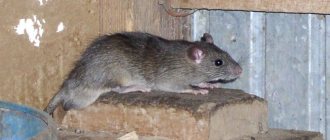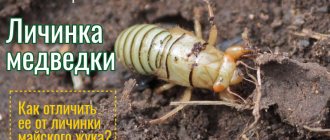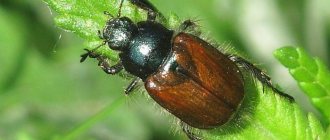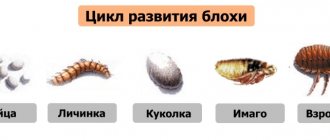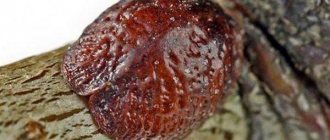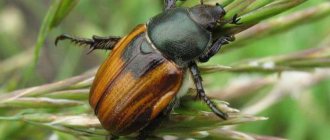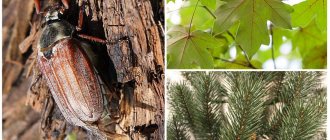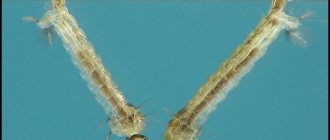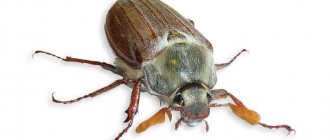Blood-sucking insects, which live mainly on the skin and fur of domestic animals, bring a lot of trouble to humans. Flea bites can lead to allergies, and especially impressionable people simply find it unpleasant to be in an apartment infested with parasites, which is understandable. In addition, in theory, parasites can be carriers of many dangerous infectious diseases, although in practice cases of infection from pests are extremely rare.
Before starting an active fight against fleas, you should determine whether these particular parasites are actually infested in your home, and not, for example, bedbugs or linen lice. That is why you should know how to identify adults (as well as larvae, pupae, eggs) and distinguish them from other common pests.
Adults
The parasites that most insecticides target are adult fleas. An adult insect can reach up to 5 millimeters in size, has a black (these are young fleas) or brown color, and is covered with scales. In the animal's fur, the pest is somewhat reminiscent of a small grain of a plant.
The main difference between fleas and other insects: pests can jump up to thirty centimeters in length, escaping from danger or moving from victim to victim. Sometimes these jumps can be seen with the naked eye. Fleas differ from bed lice in their large size, and from bedbugs in their ability to jump.
Causes of parasites
The first reason that comes to mind for insects is dogs and cats. Indeed, most often it is pets who become the source of infection. But there are many other ways to bring bloodsuckers into your home.
- Basement of the house. Fleas in the basement of an apartment building both quickly appear and quickly begin to multiply. Residents of the first floors suffer from them especially.
- Shoe sole. Sometimes people themselves bring eggs of earthen species to their homes on the soles of their shoes. And they cannot always be detected immediately. Parasites are usually noticed when they have already actively begun to reproduce.
- Rent or sale of an infected apartment. Apartment owners may not completely get rid of pests before selling or renting. If you are unlucky enough to encounter such hosts, prepare for a long and persistent struggle with insects.
- Neighbours. It happens that not the most clean neighbors contribute to the spread of parasites not only in their apartment, but throughout the house.
Having discovered an infestation of blood-sucking insects, it is advisable to find out where they came from, otherwise all efforts to destroy them will be in vain.
Of course, the main reason why parasites linger in your home is the presence of favorable conditions. Lack of fresh air, uncleanliness, dirt in the house, dampness, clutter - all this contributes to their active reproduction.
Flea
Indoor fleas feed on blood, so the inhabitants of the house become an excellent source of food for them. This is the main danger, because they can carry various dangerous, sometimes even fatal diseases, as well as helminth eggs.
Pests leave painful bites. The skin at the bite sites is irritated and itchy, and the points themselves are located on the same line. Sometimes bites can cause severe allergies, especially in children.
Flea eggs and larvae
Flea eggs (photo below) are very small and difficult to notice with the naked eye. The distribution of eggs ensures a unique process of “laying” them: the female literally “shoots” them with enormous speed. This is why it is rare to find flea eggs on the fur of the pet itself.
Worm-like larvae, which hatch from eggs, often scurry under furry pets' carpets and bedding, behind baseboards and in other hard-to-reach places. Flea larvae are white in color, they are very similar to fly larvae and feed on waste products of adults or small vegetation. They are also very rarely found in the fur of a cat or dog.
Facts from biology
Fleas are wingless insects whose flat body is laterally compressed. The long legs are strewn with spines and hairs, and antennae are hidden inside the recesses on the sides of the head. The oral apparatus, adapted for piercing the skin and sucking blood, consists of a proboscis, a pair of palps and a pair of short mascilla. The body length of fleas is usually 2-4 mm, in rare species it reaches 6-8 mm. Flea larvae are worm-shaped, without legs, with a rounded head, each body segment is covered with hairs.
Fleas feed on the blood of mammals and birds and live on the body of the host or in nests, burrows and animal trails. Flea eggs are transparent white, oval in shape. Females drop eggs in the owner's fur or in his nest.
In nature, non-adhesive flea eggs laid on the host's body roll down the hairline and fall into the litter of a nest or shelter, where larvae soon appear. In an apartment, eggs accumulate in floor cracks, in carpets, and in places where house dust and dirt accumulate.
Flea larvae develop in the soil and in the substrate of nesting bedding, and in an apartment - in pets' bedding, in carpets, in upholstery and in dust on the floor. They feed on the anal secretions of adults and lead an active life. Typically, 50-60% of each flea colony consists of larvae.
Having reached its final size, the larva weaves an irregularly shaped cocoon in the host's nest or carpet and pupates there. For the imago to emerge, mechanical stimulation is required, such as vibration from feet on the floor. Therefore, the appearance of a person in an empty room provokes a sudden emergence of a mass of adult fleas from the pupae.
Without signals of the presence of a host, the flea pupal stage lasts up to 5 months. Under favorable conditions, the flea development cycle lasts 2-4 weeks. Flea eggs, larvae and pupae are not visible without a thorough examination.
Video: Reproduction of fleas - larvae in the carpet
Adults are extremely mobile, moving deftly in fur and feathers; moreover, the body of fleas is equipped with ridges, bristles and spines that help such movement. Some species live permanently on the host's body, while others live in the nest and attack the host only for food.
Dog and cat fleas (Latin names Ctenocephalides canis and C.felis), as well as the human flea (Pulex irritans), attack people and breed in living spaces, creating discomfort and even making them uninhabitable.
How to get rid of adults, their eggs, pupae and larvae
The fight against parasites should be comprehensive: carried out in several ways and include repeated treatment of the premises over time, as well as preventive measures. You should not only get rid of annoying insects from your pets, but also disinfect your apartment.
There are several ways to deal with pests that cause discomfort to your cat or dog. Most often used:
- aerosols;
- flea collars;
- detergents (shampoos and soaps);
- drops on the withers.
Flea tablets and injections are also common abroad.
All these remedies are relatively safe for the animals themselves, but have a detrimental effect on parasites: the poison paralyzes the pest, which causes the vital organs and systems of the insects to fail, and the flea dies. There will be no harm to your pet from using such drugs if you choose the right product (according to the animal’s age, breed, state of health, weight) and use it in accordance with the instructions.
The premises are also treated using insecticides or traditional methods. In case of severe infestation, it is more advisable to call a team of specialists to quickly, effectively and safely treat the premises from parasites.
How quickly do fleas reproduce?
How many eggs do fleas lay?
The rate of flea reproduction is the result of extraordinary fecundity. On average, the female lays 25 eggs per day. The eggs reach maturity within 17-26 days. This means that in a month one individual will have thousands of offspring. The female begins to lay eggs on the first or second day after hitting the host. Initially, she lays up to 10 eggs, and on the 9th day, reproductive function reaches its peak, reaching up to 50 eggs per day.
In natural conditions, fleas live on average up to 7 days, in laboratories - up to 100 days, and on domestic animals that groom themselves, fleas live much less. In a week, the cat cleans and eats up to 50% of the fleas on its body - 3-12 pieces per day. How many eggs a female will have time to lay depends on her life expectancy. On average, one female lays 200-800 eggs during her life.
What is the survival rate of different stages of development
However, survival factors also influence how fleas reproduce. Not all eggs reach maturity, this is due to the following reasons:
- Only 30-45% of eggs are initially fertile (capable of completing all stages of the life cycle)
- Some of the eggs are eaten by their owners - cats and dogs. For example, a cat eats up to 30% of eggs per day
- Eggs constantly fall, and their further fate depends on random factors - those that fall on a dry, illuminated surface die. Eggs develop only in humid conditions and in a temperature range of 10-38 degrees above zero
- The hatched larva will survive only if the excrement of adult fleas is scattered around the egg.
- In addition to excrement, the larvae feed on other larvae - at this stage, fleas practice cannibalism
- Mature pupae emerge from cocoons only when a potential host appears. In the absence of animals and humans, fleas remain at this stage for up to 5 months, after which they die
Now for a little math. If you imagine that a dog or cat has 5 fleas on its body, each of which lays 25 eggs a day, then a total of 125 eggs come out. Of these 125, only 30 will reach maturity, so these females will lay 210 eggs in 7 days of life, which will reach maturity. If we assume that the life cycle of fleas takes 20 days, then it turns out that already on the 30th day the flea colony will number 4400 mature individuals! This is why fleas are classified as insects that reproduce quickly.
Are they dangerous for humans?
Fleas and their larvae can be carriers of various serious diseases that pose a threat to human life:
- Bubonic plague;
- encephalitis;
- anthrax;
- trypanosomiasis;
- tularemia;
- typhus and relapsing fever, etc.
The likelihood of a threat may not be the norm, but a certain percentage remains. This is the most terrible threat to human health and life.
In addition, if you eat food without washing the eggs with your bare hands, you can become infected with various types of worms.
Description of appearance
Fleas are representatives of arthropods. The body of parasites is narrow, smooth, flattened laterally. Color ranges from light red to deep brown or black. Outside, individuals are covered with a dense chitinous cover, numerous outgrowths of which in the form of spines and bristles help to stay on the host or in its habitat.
Additionally, fixation is provided by special plates (ctenidia) equipped with notches. These evolutionary adaptations lead to significant difficulties in getting rid of fleas; parasites can only be mechanically destroyed by crushing them on a hard surface.
The length of the insect in the hungry state is from 1 to 5 mm in length. When saturated, due to the stretching of the abdomen, the size can increase to 1 cm, and the fertilized female reaches 1.5 cm.
The body is divided into 3 parts: head, chest, abdomen. Adults lack wings. The structure of the limbs is ideal for movement: powerful and longer hind legs act like a catapult during a jump, which allows the insect to move over gigantic distances compared to the size of the flea itself - up to 30-50 cm. Each limb is equipped with claws.
The sensory organs are represented by the eyes, the olfactory organs on the head and a special apparatus called the pygidium, which is located on the abdomen. Being an organ of touch, it sensitively reacts to the movement of air, informing the parasite about a possible threat.
The mouthparts are piercing-sucking type. Having bitten through the skin, the parasite expands the wound, plunges into it, reaching a blood vessel. In this case, enzymes are injected that prevent hemostasis.
Identifying Dog Fleas
You should periodically check your pet for parasites. And, of course, dog fleas will immediately make themselves felt. To do this, the dog needs to be placed on a white cloth or paper and scratched, after which the crumbled blood and excrement will be noticeable. If you wet them with water and brown spots appear, you can be sure that the animal has fleas.
In addition, the dog will be in an agitated state due to painful flea bites. He can also become quite inattentive, scratching himself all the time. Various infections can get into the wounds formed at the site of bites. Therefore, if a dog shows signs of itching, lack of appetite, weight loss, nervous condition, poor concentration, then you urgently need to save the animal.
What they look like
Tiny, oval-shaped, white with a translucent body, flea eggs can only be clearly seen under a microscope. They have no legs, and their entire body is covered with tiny hair. The large head, in comparison with the body, has powerful jaws, which allows the larva to eat hard food - easily chew organic debris. The transparent body makes it possible to see the esophagus. The length of the egg is two to three, less often four to five millimeters. In the latter case, individuals are considered very large. In appearance, it resembles a fly larva, but unlike it, it is not so mobile and transparent.
lice eaters
Small (1-2 mm long) wingless insects with a body flattened in the dorsoventral direction. The head is wider than the chest, flat, quadrangular. The mouthparts are gnawing type. The eyes are poorly developed. The chest consists of three and the abdomen of nine segments. The abdomen is longer than the head and chest combined.
Lice eaters are permanent ectoparasites. Development according to the type of incomplete transformation. Females lay eggs, gluing them to the root part of the hair with the uterine secretion. The development cycle is the same as that of lice.
Epizootological data. Insects (ectoparasites) of dogs are ubiquitous. Found on animals at all times of the year. Fleas are poorly adapted to certain types of animals and can spread from dogs to humans. Dog lice and lice parasitize only dogs.
Infection of animals occurs through direct contact between healthy animals and infected animals, as well as through care items.
Parasites are transmitted to puppies from their mother. Ectoparasites on dogs are more common under unsatisfactory conditions of keeping them in damp rooms and poor nutrition.
Insects can be mechanical and biological carriers of pathogens of invasive, infectious and viral diseases. Thus, dog, cat, human fleas, and dog lice eaters are intermediate hosts of the cestode.
Pathogenesis
Fleas and lice, when sucking blood, pierce the skin and inject saliva, which has toxic properties. In intensively infested patients, erythropenia develops.
Ectoparasites, crawling over the body of animals and biting them, cause itching and scratching, leading to the development of dermatitis. At the same time, dogs are deprived of rest, their attention, obedience and performance decrease, and the animal spends a lot of energy fighting ectoparasites.
Lifestyle and nutrition of future parasites
Flea larvae are not parasites, since they feed on decaying organic compounds, which make up particles of dead plants, excrement of formed fleas, containing undigested crusts of the victim's blood.
The larvae themselves do not feed on blood, therefore in this state they are harmless to humans and animals.
Maturation of the larvae lasts from 2 to 14 days. After this, the eggs hatch and small parasites continue to develop. The period of final maturation depends on environmental conditions; the more comfortable the larva feels, the faster the process of formation of the individual occurs.
If the ambient temperature is warm enough and there is a high level of humidity, the larvae will develop into an adult within a couple of days. An underdeveloped individual feeds on the feces of mature individuals, dried blood crust, and other layers of organic matter.
As the larva grows, it molts (3 times), after which it pupates like a butterfly. The time the larva remains in the cocoon ranges from several weeks to several months. It depends on the environmental conditions.
If they are unfavorable, the cocoon can remain unchanged for a year until the victim is in close proximity. According to scientists, even in the pupal state, a flea can smell blood. After emerging from the cocoon, the final stage of insect development begins.
What pathogens are transmitted?
In addition to the fact that the bites of all representatives of this order are painful, they also pose a more serious danger. Despite their small size, these pests transmit a lot of different diseases. Here are just some of the pathogens that fleas carry:
- Thousands of bacteria, including the causative agents of salmonella and tularemia.
- Several types of viruses, including those that cause infections such as hepatitis B and C, as well as encephalitis.
- Eggs of dangerous helminths.
- The causative agent of the plague that wiped out a third of Europe in the Middle Ages. And today the plague periodically resurfaces in some regions of the world.
- The causative agent of typhoid fever, which at the beginning of the century was a very common disease.
A massive attack of puppies, kittens or children by blood-sucking reptiles is dangerous because it can lead to the development of anemia.
Neighborhood with fleas is extremely undesirable, as they transmit deadly diseases. If they are detected in the house, on animals or people, it is necessary to take action as quickly as possible.
Symptoms of fleas in animals
There are such types of fleas as human, cat, dog, rabbit and rat. Just by their name you can determine with the help of which owner they lead their lifestyle.
The most common fleas we encounter are cat and dog fleas, which parasitize cats and dogs. To detect these insects on an animal’s body, you first need to carefully examine it. Most often, fleas are noticeable in the abdomen, around the ears, and also on the inner thigh. When bathing your animal, you need to pay attention to the skin of the eyes. After all, if there are parasites on the body, they will accumulate in dry places. And even if you cannot see an adult flea, you can easily notice poppy-like waste products.
Where do fleas live
Fleas live everywhere. As a rule, the habitats of parasites in the wild are associated with burrows, nests of wild animals, human habitation and premises for livestock. The so-called house fleas (or bed fleas) are nothing more than a collective image of all those bloodsuckers that have settled in a person’s house. These can be different types of fleas, and any warm-blooded creature in the house can become their host.
So fleas in an apartment choose secluded corners: carpets, spaces behind baseboards, bedding and nests of pets; if cluttered, they can be found in closets and inside sofas. Fleas appear on the bed when there is a rare change of linen or accumulation of dust.
In basements, ground floors, cellars, parasites can also live in garbage heaps, grass, attacking mice, rats and pets (which in turn can bring them to your apartment).
Important! The appearance of fleas in an apartment is facilitated by clutter and low levels of housing hygiene.
What is the threat from fleas to humans?
Usually people do not suffer from flea bites. At the same time, children and the elderly are the most sensitive to flea bites. It is necessary to keep in mind that fleas can be carriers of viruses and causative agents of diseases in humans such as hepatitis B and C, brucellosis (brucellosis infection in humans), typhus, E. coli, pasteurellosis, and plague bacillus.
Prevention. Prevention is based on periodic inspection of your rabbits. Rabbit owners must strictly observe the veterinary and sanitary rules for keeping rabbits, maintain cleanliness in the cages (at least once every 10 days, change the bedding in the nests and cages to fresh ones, and burn the contaminated ones containing flea larvae or remove them and store them for biothermal sterilization), periodically disinfect the cage and cleaning equipment with a 3% creolin solution, boiling water, steam or a blowtorch flame. Prevent cats and your dogs from getting fleas. At home, carry out regular wet cleaning and household disinfectants.
Treatment
To destroy ectoparasites on the body of dogs, insecticides are used in the form of dusts, solutions, emulsions and aerosols. When choosing a drug, take into account the duration of its action and toxicity to the animal’s body. The effect of an insecticide depends not only on its form and quality, but also on the thoroughness of application to the skin of the animal.
All drugs have a stronger effect on the larvae, then on the adult forms, killing them, but do not have a detrimental effect on the eggs. In this regard, all treatments must be carried out at least twice: in the summer - after 10-12 days, in the winter - after 14-18 days. When using insecticides with a long residual effect, they are limited to a one-time treatment.
Dogs are washed with pet shampoo, which leads to the death of ectoparasites, cleansing of the skin and the disappearance of odor.
In the cold season, dusts of pyrethrum, 2% sevin, 3-5% chlorophos (10-30 g per animal) are used. During treatment (10-15 minutes), the animals are placed in a special bag with a purse-string suture to secure the upper part of the neck. It is recommended to carry out dust treatment outdoors or in a spacious, well-ventilated room. Make sure that the drug does not get into the feed. Persons carrying out processing must wear protective clothing, safety glasses and gauze masks.
They also offer for use a 0.75-1% aqueous solution of chlorophos, 0.5% aqueous emulsions of trichlorometaphos-3 and karbofos, 0.15% cyodrine emulsion, 0.25-0.5% suspension sevin, 0.5% ectobacterin suspension, 4% K soap emulsion, Akrodex aerosol and dermatosol.
Features of character and lifestyle
Photo: Flea insect
Some fleas (such as rabbit fleas) are very host specific, while other species parasitize a variety of mammals. The cat flea infects not only the domestic cat, but also dogs, foxes, mongooses, possums, leopards and other mammals, including humans, if its normal hosts are not available.
Related mammals tend to parasitize fleas, which are themselves related. Thus, peak rabbits (Ochotona) living in the rocky mountains are infested with two distinctive genera of fleas that are also found on peaks in the mountains of Asia, indicating a close phylogenetic relationship between these geographically separated hosts. Bird fleas have relatively recently adapted to their hosts. They share several similarities, one of the most obvious of which is the increase in the number of ridges on the upper surface of the thorax, which serve to anchor them within the feathers.
Interesting fact: Monkeys do not eat fleas, nor do horses and most ungulates. The most parasitic group of mammals are rodents. Their habit of building nests in burrows promotes the development of flea larvae. Animals without permanent residence tend to carry fewer fleas.
Although both flea sexes feed voraciously and repeatedly on blood, they survive for varying periods of time, regardless of the host. For example, a rabbit flea can survive nine months at temperatures near freezing without feeding.

